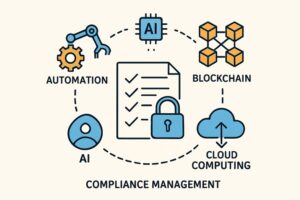How Technology Transforms Compliance Management
Key Takeaways
- Automation and AI reduce repetitive manual processes, improve accuracy, and accelerate compliance decision-making.
- Blockchain delivers tamper-proof records, supporting transparency and security in all compliance activities.
- Real-time monitoring enables organizations to address issues and manage emerging risks proactively.
Introduction
Amid a rapidly shifting regulatory environment, organizations today face unprecedented challenges in maintaining robust compliance frameworks. Traditional compliance practices, often manual and fragmented, no longer keep pace with the volume and complexity of modern regulations. Innovative technology solutions enable companies to overhaul their approaches and achieve greater efficiency, accuracy, and security. One powerful technology in this space is SCIP, which offers organizations a flexible and intelligent platform to strengthen compliance management at every level.
With compliance requirements growing across sectors such as finance, healthcare, supply chains, and more, new tools are reshaping how organizations track, document, and report on regulatory standards. Businesses can use automation, artificial intelligence, blockchain, and cloud-based platforms to reduce manual workloads and mitigate risks before they threaten operational continuity. Digital transformation in compliance management isn’t just a trend; it’s quickly becoming essential for organizations that want to remain competitive and resilient.
Automation: Reducing Manual Effort and Errors
Manual compliance tasks—like logging activities, tracking policy changes, and generating reports—are tedious and can introduce inconsistencies and mistakes. Adopting automation, primarily through Robotic Process Automation (RPA) tools, streamlines these repetitive workflows across departments. RPA can rapidly scan and update compliance records, cross-check company activities with regulatory requirements, and flag potential issues for review. Organizations can better allocate compliance resources for strategic reviews and higher-value tasks by diminishing reliance on manual processes and ensuring data accuracy. The result is a compliance operation that’s more productive and far less prone to human error.
Artificial Intelligence: Enhancing Risk Detection
Artificial Intelligence (AI) is a game changer for compliance risk management. AI engines powered by machine learning algorithms sift through massive volumes of transactional and operational data to spot patterns, identify anomalies, and predict risks long before they become violations. In industries such as financial services, AI-powered systems continuously monitor transactions and user behaviors, flagging outlier activities for compliance teams to investigate. This form of proactive oversight allows companies to detect threats, act on them quickly, and minimize non-compliance’s financial and reputational costs. AI also helps standardize regulatory interpretations across large organizations, reducing ambiguity and ensuring a consistent approach to compliance processes. For more on AI’s impact, see this Forbes overview.
Blockchain: Ensuring Transparency and Security
Blockchain technology is redefining the standards of compliance record-keeping. With its decentralized, immutable ledger, blockchain ensures all transactions are permanently logged and visible only to authorized parties. This makes the data nearly impossible to tamper with, creating a trustworthy audit trail for regulators or oversight agencies. Technology is particularly valuable when transparency and data integrity are crucial, such as in global supply chains or healthcare. Organizations can use blockchain-based systems to trace the custody of assets, guarantee document authenticity, and securely share compliance evidence with external parties. As legislative scrutiny continues, blockchain offers a clear pathway toward accountable, auditable, and fully secure compliance records.

Real-Time Monitoring: Proactive Compliance Management
Regulatory environments are rarely static, so real-time compliance monitoring is critical. Cloud-based compliance platforms enable organizations to detect and address risks the moment they arise, rather than after an incident. These solutions deliver instant alerts about policy breaches, suspicious transactions, or emerging threats, prompting compliance officers to investigate and remediate issues in real time. This proactive posture helps organizations reduce compliance failures’ duration, damage, and recurrence, ultimately protecting their reputation and bottom line. Dynamic monitoring also allows continuous improvement, as teams can update controls and processes based on real-world findings and shifting regulatory requirements. The importance of real-time compliance tracking is highlighted in reports by The Wall Street Journal.
Data Analytics: Informed Decision-Making
Data analytics tools transform how organizations design, execute, and measure their compliance strategies. By aggregating and analyzing information from multiple sources, these platforms uncover patterns of behavior, pinpoint inefficiencies, and benchmark performance against regulatory expectations. Leaders can then use these insights for more informed, data-driven decision-making, such as reallocating resources, adjusting risk priorities, or planning future audits. When done well, data analytics ensures compliance programs are continually refined and business goals remain aligned with evolving regulations.
Cloud Computing: Scalability and Accessibility
Cloud-based platforms are breaking down traditional barriers to compliance management. With the flexibility of cloud solutions, organizations can seamlessly scale their compliance programs as they grow or as regulations change. Cloud computing allows for remote access to critical compliance documentation and real-time collaboration among distributed teams, streamlining responses to regulatory updates and inquiries. These systems often support rapid integration with existing software and enable better use of artificial intelligence, automation, or blockchain capabilities across the organization.
Conclusion
Embracing digital transformation in compliance is more than a technological upgrade—it’s a strategic imperative. By investing in automation, artificial intelligence, blockchain, real-time monitoring, data analytics, and cloud solutions, organizations can fortify their compliance posture, reduce costs, and respond more effectively to new regulations. Innovative platforms bring together these capabilities in an integrated environment, positioning businesses to mitigate risk and drive continuous improvement in regulatory compliance management for the future.

